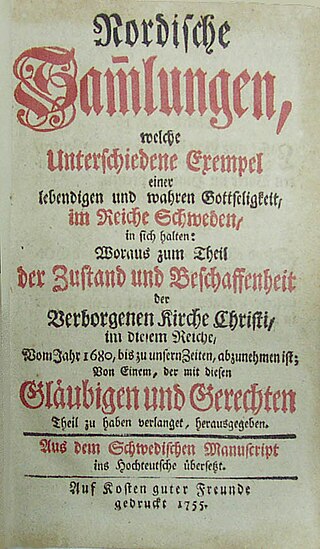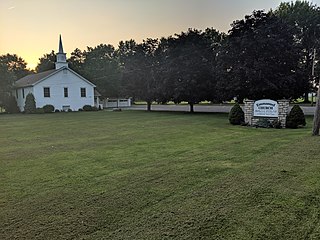Related Research Articles

The Free Methodist Church (FMC) is a Methodist Christian denomination within the holiness movement, based in the United States. It is evangelical in nature and is Wesleyan–Arminian in theology.
Pentecostalism or classical Pentecostalism is a Protestant Charismatic Christian movement that emphasizes direct personal experience of God through baptism with the Holy Spirit. The term Pentecostal is derived from Pentecost, an event that commemorates the descent of the Holy Spirit upon the Apostles and other followers of Jesus Christ while they were in Jerusalem celebrating the Feast of Weeks, as described in the Acts of the Apostles.
The Holiness movement is a Christian movement that emerged chiefly within 19th-century Methodism, and to a lesser extent influenced other traditions such as Quakerism, Anabaptism, and Restorationism. The movement is historically distinguished by its emphasis on the doctrine of a second work of grace, which is called entire sanctification or Christian perfection. Churches aligned with the holiness movement additionally teach that the Christian life should be free of sin. For the Holiness movement, "the term 'perfection' signifies completeness of Christian character; its freedom from all sin, and possession of all the graces of the Spirit, complete in kind." A number of evangelical Christian denominations, parachurch organizations, and movements emphasize those beliefs as central doctrine.
The Brethren in Christ Church (BIC) is a Christian denomination. Falling within the Anabaptist tradition of Christianity, the Brethren in Christ Church has roots in the Mennonite church, with influences from the revivals of Radical Pietism and the holiness movement. They have also been known as River Brethren and River Mennonites. The Canadian denomination is called Be In Christ.
Church of Christ may refer to:
The Primitive Methodist Church is a Methodist Christian denomination within the holiness movement. It began in England in the early 19th century, with the influence of American evangelist Lorenzo Dow (1777–1834).

Albert Benjamin Simpson, also known as A. B. Simpson, was a Canadian preacher, theologian, author, and founder of the Christian and Missionary Alliance (C&MA), an evangelical denomination with an emphasis on global evangelism that has been characterized as being Keswickian in theology.
Within many denominations of Christianity, Christian perfection is the theological concept of the process or the event of achieving spiritual maturity or perfection. The ultimate goal of this process is union with God characterized by pure love of God and other people as well as personal holiness or sanctification. Other terms used for this or similar concepts include entire sanctification, perfect love, the baptism with the Holy Spirit, the indwelling of the Holy Spirit, baptism by fire, the second blessing, and the second work of grace.
Pilgrim Holiness Church (PHC) or International Apostolic Holiness Church (IAHC) is a Christian denomination associated with the holiness movement that split from the Methodist Episcopal Church through the efforts of Martin Wells Knapp in 1897. It was first organized in Cincinnati, Ohio, as the International Holiness Union and Prayer League (IHU/IAHC). Knapp, founder of the IAHC, ordained and his Worldwide Missions Board sent Charles and Lettie Cowman who had attended God's Bible School to Japan in December 1900. By the International Apostolic Holiness Churches Foreign Missionary Board and the co-board of the Revivalist the Cowmans had been appointed the General Superintendents and the Kilbournes the vice-General Superintendent for Korea, Japan and China December 29, 1905. The organization later became the Pilgrim Holiness Church in 1922, the majority of which merged with the Wesleyan Methodists in 1968 to form the Wesleyan Church.

The conservative holiness movement is a loosely defined group of theologically conservative Christian denominations with the majority being Methodists whose teachings are rooted in the theology of John Wesley, and a minority being Quakers (Friends) that emphasize the doctrine of George Fox, as well as River Brethren who emerged out of the Radical Pietist revival, and Holiness Restorationists in the tradition of Daniel Sidney Warner. Schisms began to occur in the 19th century and this movement became distinct from parent Holiness bodies in the mid-20th century amid disagreements over modesty in dress, entertainment, and other "old holiness standards" reflective of the related emphases on the Wesleyan–Arminian doctrine of outward holiness or the Quaker teaching on the testimony of simplicity or the River Brethren and Restorationist teachings on nonconformity to the world, depending on the denomination. Christian denominations aligned with the conservative holiness movement share a belief in Christian perfection, though they differ on various doctrines, such as the celebration of the sacraments and observance of ordinances, which is related to the denominational tradition—Methodist, Quaker, Anabaptist or Restorationist. Many denominations identifying with the conservative holiness movement, though not all, are represented in the Interchurch Holiness Convention; while some denominations have full communion with one another, other bodies choose to be isolationist.

The Evangelical Methodist Church (EMC) is a Christian denomination in the Wesleyan-Holiness tradition headquartered in Indianapolis, Indiana. The denomination reported 399 churches in the United States, Mexico, Burma/Myanmar, Canada, Philippines and several European and African nations in 2018, and a total of 34,656 members worldwide.
The Metropolitan Church Association, also known as the Metropolitan Methodist Mission and Metropolitan Evangelistic Church, is a Methodist denomination in the holiness movement. The Metropolitan Church Association has congregations throughout the world, and in the 20th century, it possessed intentional communities in Wisconsin, Virginia, West Virginia, Louisiana, and Texas, among other locations.

Radical Pietism are those Christian churches who decided to break with denominational Lutheranism in order to emphasize certain teachings regarding holy living. Radical Pietists contrast with Church Pietists, who chose to remain within their Lutheran denominational settings. Radical Pietists distinguish between true and false Christianity and hold that the latter is represented by established churches. They separated from established churches to form their own Christian denominations.
The Churches of Christ in Christian Union (CCCU) is a Wesleyan-Holiness and Restorationist Christian denomination.

According to some Christian traditions, a second work of grace is a transforming interaction with God which may occur in the life of an individual Christian. The defining characteristics of the second work of grace are that it is separate from and subsequent to the New Birth, and that it brings about significant changes in the life of the believer.

Martin Wells Knapp (1853–1901) was an American Methodist minister who founded several institutions including the magazine God’s Revivalist in 1888, the International Holiness Union and Prayer League in 1897, and God's Bible School, later known as God's Bible School and College, in Cincinnati, Ohio in 1900. He was a central figure of the more radical wing of the Holiness movement.
The Interchurch Holiness Convention (IHC), formerly the Interdenominational Holiness Convention, is an ecumenical organization of denominations and congregations within the conservative holiness movement. Aligned with the conservative holiness movement, the majority of these IHC members are Methodist, though others have a Quaker, Anabaptist or Restorationist background. There are a number of denominations aligned with the conservative holiness movement, however, that are not affiliated with the Interchurch Holiness Convention. The IHC was founded in 1952 during the post-World War II era. Thousands of individuals are present at the Interchurch Holiness Convention's annual international meeting that is usually held in Dayton, Ohio or in Gatlinburg, Tennessee; in addition the Interchurch Holiness Convention hosts regional meetings at local churches in different parts of the world throughout the year.

The Evangelical Wesleyan Church, formerly known as the Evangelical Wesleyan Church of North America, is a Methodist denomination in the conservative holiness movement.

The Emmanuel Association of Churches is a Methodist denomination in the conservative holiness movement.

The Reformed Free Methodist Church (RFMC) was a Methodist denomination in the conservative holiness movement.
References
- ↑ Rodgers, Darrin J. (27 October 2011). "Holy Jumpers: Evangelicals and Radicals in Progressive Era America (review)". The Catholic Historical Review. 97 (4): 859–860. doi:10.1353/cat.2011.0154. S2CID 162390783. Project MUSE 455149.
- ↑ Long, Christopher. "Burning Bush Colony". Handbook of Texas Online.
- 1 2 Brown, Kenneth O. (2010). "House of Prayer". In Kostlevy, William (ed.). The A to Z of the Holiness Movement. Lanham: Scarecrow Press. pp. 66–67. ISBN 9780810875913.
- 1 2 3 4 5 6 Brown, Kenneth O.; Brevard, P. Lewis (1980). "Rise and Expulsion of "All Things Common"". A Goodly Heritage: A History of the Churches of Christ in Christian Union [Alternative title: From Out of the Past: History of the Churches of Christ in Christian Union]. Circleville, Ohio, USA: Circle Press, Inc. pp. 125–139. OCLC 7389573. Archived from the original on September 23, 2015.
- 1 2 Humble, Wesley E.; Kostlevy, William C. (2009). "Churches of Christ in Christian Union". In Kostlevy, William (ed.). Historical dictionary of the Holiness movement (2nd ed.). Lanham, Maryland, US: Scarecrow Press. pp. 66–67. ISBN 9780810863187.
- ↑ Brown, Kenneth O. (2009). "House of Prayer". In Kostlevy, William (ed.). Historical dictionary of the Holiness movement (2nd ed.). Lanham, Maryland, US: Scarecrow Press. pp. 151–152. ISBN 9780810863187.